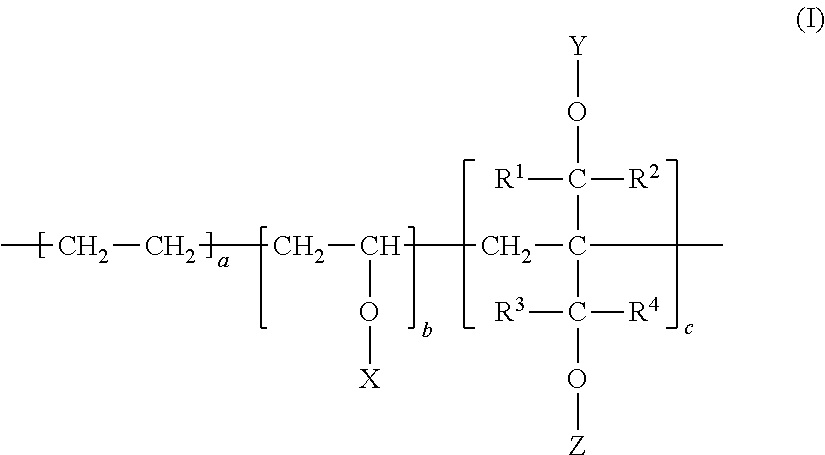Ethylene-vinyl alcohol copolymer resin composition and method for producing same
a technology of ethylenevinyl alcohol and resin composition, which is applied in the direction of synthetic resin layered products, rigid containers, packaging, etc., can solve the problems of increasing production steps and rising production costs, unavoidable decrease of transparency, and difficult to manage both gas barrier properties, etc., to achieve excellent barrier properties, excellent productivity, and excellent secondary processing ability
- Summary
- Abstract
- Description
- Claims
- Application Information
AI Technical Summary
Benefits of technology
Problems solved by technology
Method used
Image
Examples
synthesis example 1
(1) Synthesis of Modified Ethylene-Vinyl Alcohol Copolymer (Modified EVAc)
[0080]To a 50 L pressure reaction vessel provided with a jacket, a stirrer, a nitrogen inlet, an ethylene inlet, and an initiator addition port, 21 kg of vinyl acetate (R5 is a methyl group in the formula (II): hereinafter, referred to as VAc), 2.1 kg of methanol (hereinafter, may be referred to as MeOH), and 1.1 kg of 2-methylene-1,3-propanediol diacetate (R1, R2, R3, and R4 are hydrogen atoms and R6 and R7 are methyl groups in the formula (III): a compound identical to 1,3-diacetoxy-2-methylenepropane: hereinafter, referred to as MPDAc) were charged, and the temperature was raised to 60° C., and after that, nitrogen bubbling was carried out for 30 minutes to purge inside the reaction vessel with nitrogen. Subsequently, ethylene was introduced to have a reaction vessel pressure (ethylene pressure) of 4.2 MPa. After the temperature in the reaction vessel was adjusted at 60° C., 16.8 g of 2,2′-azobis(2,4-dimeth...
synthesis example 2
[0098]Polymerization was carried out in the method same as Synthesis Example 1 (1) other than changing the amount of MeOH to 6.3 kg, changing the ethylene pressure to 3.7 MPa, changing the amount of initiator to 4.2 g, and not charging the MPDAc. After four hours, when the conversion of VAc became 44%, the polymerization was stopped by cooling. Subsequently, by the same process as Synthesis Example 1, unmodified EVOH composition pellets containing 135 ppm of sodium salt in terms of sodium elements and 11 ppm of a phosphoric acid compound in terms of phosphate radicals were produced. Results of evaluation in the same manner as Synthesis Example 1 are collectively indicated in Table 1.
synthesis example 3
[0099]Polymerization was carried out in the method same as Synthesis Example 1 (1) other than changing the amount of initiator to 8.4 g and changing the amount of charged MPDAc to 0.5 kg. After six hours, when the conversion of VAc became 52%, the polymerization was stopped by cooling. Subsequently, modified EVOH composition pellets were produced and evaluations were performed in the same manner as Synthesis Example 1, and the results are collectively indicated in Table 1.
PUM
| Property | Measurement | Unit |
|---|---|---|
| RH | aaaaa | aaaaa |
| carbon number | aaaaa | aaaaa |
| degree of saponification | aaaaa | aaaaa |
Abstract
Description
Claims
Application Information
 Login to View More
Login to View More - R&D
- Intellectual Property
- Life Sciences
- Materials
- Tech Scout
- Unparalleled Data Quality
- Higher Quality Content
- 60% Fewer Hallucinations
Browse by: Latest US Patents, China's latest patents, Technical Efficacy Thesaurus, Application Domain, Technology Topic, Popular Technical Reports.
© 2025 PatSnap. All rights reserved.Legal|Privacy policy|Modern Slavery Act Transparency Statement|Sitemap|About US| Contact US: help@patsnap.com



